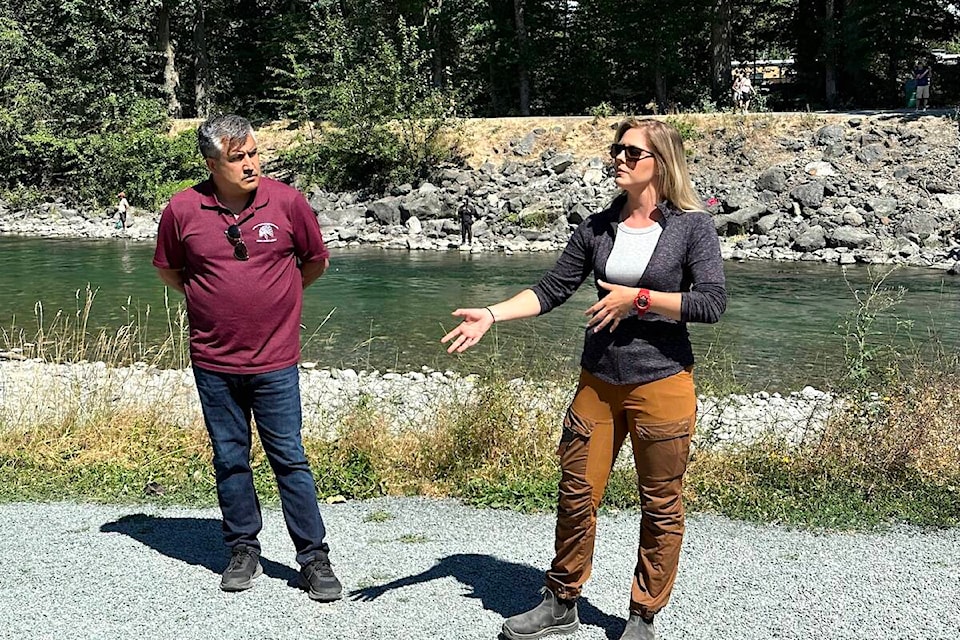The cutting-edge sonar equipment just down from the Vedder Bridge is counting salmon around the clock.
It’s the fourth year of Semá:th First Nation’s five-year Conservation, Guardianship and Harvest plan. They celebrated Tuesday with an opening ceremony, and welcome song on the south side of the Vedder-Chilliwack River at Crossing Park.
Semá:th councillor Chris Silver underlined the critical importance of the river, land, and the salmon:
“Just before we start the song, I would like to announce that we’re on the shared and traditional and unceded territory of the Soowahlie, Ts’elxwéyeqw, and Semá:th people,” Silver said.
“All our villages intertwined right at this one point and a majority of our people utilized every part of the river. I just wanted to give an explanation because this land is so very important to us; this area is so very important to us and our number one food source - the salmon.”
The Conservation, Guardianship and Harvest team will be on-site collecting data until the first week of August on the sockeye and chinook salmon runs that are returning.
Semá:th councillor Troy Ganzeveld said ultimately they’re after a better understanding of the number of fish that are coming through the system, as well as catch rates, by species, and size, the usage, and recreational impacts to help the nation “re-establish stewardship of the resource” and help the struggling salmon stocks recover, and rebound.
The goal of the stock assessment and abundance survey is preservation and restoration of salmon, while promoting sustainable harvest management. Traditional fishing knowledge from Semá:th fishers and knowledge keepers has been guiding their use of the sonar for the survey. The selective fisheries they’ve been testing out on weekends have been focused on salmon while avoiding stocks of concern, such as Cultus and/or Chilliwack Lake sockeye. By focusing on the Sumas River for harvesting in food, social and ceremonial fisheries, they provide an alternative to Fraser River main stem fisheries.
Amada Gawor, Semá:th natural resource officer, said the information the team is collecting will help “build out conservation” for the longer term.
“We’re trying to work and spread and share our information that we are collecting with other users, other stakeholders, with the Department of Fisheries, with City of Chilliwack and with the recreational angler societies as well.
“We really want to get that information out and it’s time. The salmon are in crisis so we really need to understand the impacts that they’re experiencing when heading to their spawning grounds,” Gawor said.

The team asks local residents, visitors and all river users to be aware of the project, and to offer support by avoiding the equipment under the bridge, the trailer, as well as the marked set nets, which will be identified with corks and buoys in the Sumas-Chilliwack watershed.
The gear that Semá:th invested in is super high-tech.
Gawor explains: “To explain what you’re seeing here on-site in the water, we have our sonar set up and this is a high-frequency Adaptive Resolution Imaging Sonar or ARIS.
“So this is the same unit that’s used at the Fraser River Mission hydro-acoustic operations.
“Essentially what we’re able to do is position the sonar so it’s shooting straight across the channel, and we’re actually able to get the full coverage and to see how many salmon are actually making it upstream, and downstream, and we’re also able to get an idea of their behaviour as well.”

The technicians are working from a spot above the river, where the sonar equipment is within their field of vision, monitoring the computer screens, and resulting data sets. The salmon are grey blips on the sonar screen.
As this phase of work gets underway they are hoping to get word to local residents, visitors and all river users about their work on the water. They’re asking everyone to offer support by avoiding the ARIS sonar equipment under the bridge, the trailer, as well as the marked set nets, identified with corks and buoys near the confluence of the Sumas-Chilliwack system.
Gawor echoed Ganzeveld’s point about partnerships.
“A big part of this is also building relationships and accountability and trust between all different user groups and government as well.”
“So being able to share that information to understand that we all do want to see the salmon come back and we want to see them come back in good numbers so that everyone can partake as well.”
Eddie Gardner, councillor with Skwah First Nation, who was at the opening, called the work “quite remarkable” in its scope and vision, and noteworthy that Semá:th leadership is forging ahead using their own source funds to undertake the work.
“It’s the nation taking stewardship, but in collaboration with sportfishers and other groups, to develop collaborative relationships based on trust.”
Do you have something to add to this story, or a news tip? Email:
jennifer.feinberg@theprogress.com
@CHWKjourno
Like us on Facebook and follow us on Twitter.
